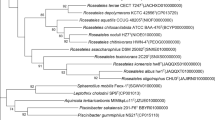Abstract
A long-rod-shaped thermophilic microorganism, strain KW11, was isolated from a hot springs located in the Kawarayu, Gunma, Japan. Cloning and preliminary sequence analysis of 16S rDNA showed that this isolate belongs to the genus Thermus. The cells were 10–20 μm long, about 0.8 μm in diameter, and produced no pigment in contrast with most of the Thermus species previously reported. KW11 was an aerobic heterotroph and grew at temperatures ranging from 40–73°C, with optimal growth occurring at 68°C. The pH range for growth was from 5.8–8.9, with optimal growth around pH 7. KW11 was sensitive to ampicillin, penicillin G, kanamycin, and streptomycin. The G+C content of DNA was 69 mol%. The main fatty acids were 16:0 (52.9%), iso-15:0 (22.1%), and iso-17:0 (15.6%). The 16S rDNA sequence of KW11 showed 96.0, 95.8, and 95.4% similarity with the sequences of T. aquaticus, T. igniterrae, and T. thermophilus, respectively, and less than 95% with other Thermus species. The physiological differences and phylogenetic evidence indicated that strain KW11 represents T. kawarayensis, a novel species of the genus Thermus. The type strain is isolate KW11T (JCM12314, DSM16200).




Similar content being viewed by others
References
Brock TD, Freeze H (1969) Thermus aquaticus gen. n. and sp. n., a nonsporulating extreme thermophile. J Bacteriol 98:289–297
Chung AP, Rainey FA, Valente M, Nobre MF, da Costa MS (2000) Thermus igniterrae sp. nov. and Thermus antranikianii sp. nov., two new species from Iceland. Int J Syst Evol Microbiol 50:209–217
Felsenstein J (1993) PHYLIP (Phylogeny Inference Package) version 3.5c. Distributed by the author, Department of Genetics, University of Washington
Higgins D, Clustal W (1998) Multiple sequence alignment. http://clustalw.genome.ad.jp/. Cited 5 Feb 1998
Hudson JA, Morgan HW, Daniel RM (1987) Thermus filiformis sp. nov., a filamentous caldoactive bacterium. Int J Syst Bacteriol 37:431–436
Kimura M (1980) A simple method for estimating evolutionary rates of base substitutions through comparative studies of nucleotide sequences. J Mol Evol 16:111–120
Kristjansson JK, Hjorleifsdottir S, Marteinsson T, Alfredsson GA (1994) Thermus scotoductus, sp. nov., a pigment-producing thermophilic bacterium from hot tap water in Iceland and including Thermus sp. X1. Syst Appl Microbiol 17:44–50
Oshima T, Imahori K (1974) Description of Thermus thermophilus (Yoshida and Oshima) comb. nov., a nonsporulating thermophilic bacterium from Japanese thermal spa. Int J Syst Bacteriol 24:102–112
Stackebrandt E, Goebel BM (1994) Taxonomic note: a place for DNA-DNA reassociation and 16S rRNA sequence analysis in the present species definition in bacteriology. Int J Syst Bacteriol 44:846–849
Tamaoka J, Komagata K (1984) Determination of DNA base composition by reversed phase high-performance liquid chromatography. FEMS Microbiol Lett 25:125–128
Williams RAD, Smith KE, Welch SG, Micallef J, Sharp RJ (1995) DNA relatedness of Thermus strains, description of Thermus brokianus sp. nov., and proposal to reestablish Thermus thermophilus (Oshima and Imahori). Int J Syst Bacteriol 45:495–499
Williams RAD, Smith KE, Welch SG, Micallef J (1996) Thermus oshimai sp. nov., isolated from hot springs in Portugal, Iceland, and the Azores, and comment on the concept of a limited geographical distribution of Thermus species. Int J Syst Bacteriol 46:403–408
Author information
Authors and Affiliations
Corresponding author
Additional information
Communicated by K. Horikoshi
Rights and permissions
About this article
Cite this article
Kurosawa, N., Itoh, Y.H. & Itoh, T. Thermus kawarayensis sp. nov., a new member of the genus Thermus, isolated from Japanese hot springs. Extremophiles 9, 81–84 (2005). https://doi.org/10.1007/s00792-004-0419-y
Received:
Accepted:
Published:
Issue Date:
DOI: https://doi.org/10.1007/s00792-004-0419-y




